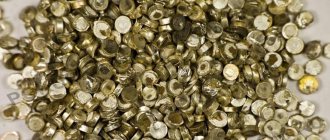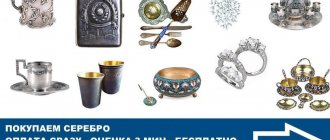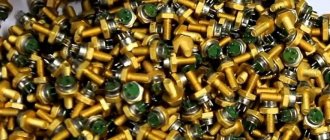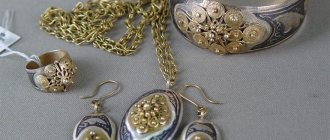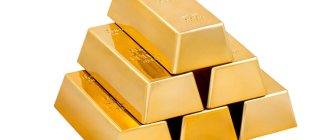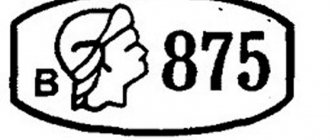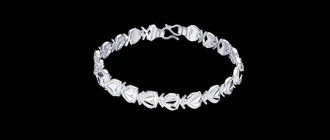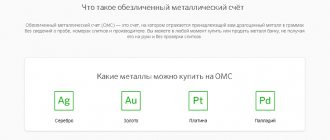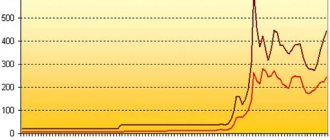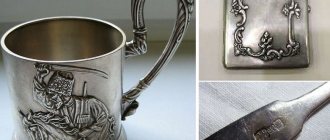Good day! Let's talk about a type of silver that you won't find in boxes among precious stones, but can be found where there is electrical equipment - that is, almost everywhere. This is technical silver.
Unlike gold, which is considered primarily a jewelry and investment precious metal, silver is widely in demand in industry. It is used in the manufacture of:
- wires;
- batteries;
- contacts;
- wires;
- solders and much more.
A huge amount of silver of varying purity is found around us in the form of grains, thin films, scrap and sputtering. Its volume is tens or even hundreds of times greater than the volume of metal that we wear in the form of jewelry.
What kind of silver is this
Strictly speaking, there is no such type of silver as “technical”. This is the name given to any silver alloy used not in jewelry, but in production.
Composition and properties
The main alloying component in a jewelry alloy is copper. The technical range is wider: cadmium, zinc, tin, nickel, and aluminum may be present. Their proportions are calculated based on the desired result.
Cadmium, zinc and tin lower the melting point, which makes alloys containing them valuable solders. True, cadmium makes the product more expensive, and zinc negatively affects its strength, so there are no universal solders - the composition is selected individually for the task.
Iron will not combine with Ag into a homogeneous mass and is considered an undesirable impurity.
Strength
Strength is also determined by the composition of the alloy. Some metals significantly increase the fragility of silver, and they are not alloyed with them or are introduced to a limited extent. This:
- lead;
- aluminum;
- tin (with a content of more than 9%);
- zinc (with a content of more than 14%).
What is the standard of this silver?
The purity of the alloy varies depending on the function it performs. “Magnetic technical silver” used in contact plates, buttons and switches is 60-65% pure - that's 600-650 fineness in the metric system. It is low-grade enough for the introduced ligature to exhibit magnetic properties.
“Non-magnetic technical silver” with a purity of 80–85% is a precious metal of 800–850 fineness, close to 875, which is used everywhere, although it is inferior in popularity to 925 fineness for jewelry. Solders are made from alloys, the fineness of which can be 400, 600, 620, 700 - in general, any number of metric units.
What stands apart in this series is the galvanic coating, which is used to silver the parts. Due to the peculiarities of the technological process, such metal can only be purest - 999 fine. The film on the product obtained as a result of electrolytic action is so thin that it is difficult to remove and remelt. Thickness is measured in microns (µm) - thousandths of a millimeter.
Ore mining
Although silver is found in nature in the form of nuggets, it is, however, a rather rare occurrence. The main part of the precious mineral is located in direct or complex deposits. This chemical element is extracted using both open and closed methods.
Mine method
This method is applicable in the case of deep mineral deposits intended for extraction. After completing geological exploration, sampling and analysis, a conclusion is issued on the feasibility and method of extraction.
In the case of mine construction, it is common practice to use mining equipment or carry out blasting operations. The resulting rock is then removed to the surface.
Career method
The fundamental difference between this method and the closed mining method is that there is no need to construct a complex of underground structures. Since this method is used when an ore body is located near the surface of the earth, after opening the soil, the extraction of fossil deposits is usually carried out with excavators, often accompanied by explosions in the process of developing new layers. The ore is then loaded onto heavy vehicles and sent for processing.
Silver mining
Where is it contained?
Technical alloys are used to create much of what we use every day. If you are reading this article at work, look around and look at the office equipment - there is silver in every device and microcircuit. One power supply contains 1.5 g.
The more modern the device, the less precious metals it contains and, accordingly, the more difficult it is to extract them.
The state controls the disposal of equipment not only for reasons of environmental safety, but also to reduce the loss of precious metals during processing. Only licensed organizations can accept high-tech scrap containing precious metals from the population—for example, there are several dozen of these in Moscow.
World reserves
According to information provided by the US Geological Survey, the top places in the table of the world's leading powers with the largest reserves of silver are:
- Peru and Poland. Both have about 110 thousand tons of this precious metal. There are other data: Peru – 120 thousand tons. Poland – 100 thousand tons.
- Australia – 89 thousand tons.
- China – 41 thousand tons.
- Mexico – 37 thousand tons.
- Chile – 26 thousand tons.
- USA – 25 thousand tons.
There are no data for the Russian Federation, although according to estimates by a number of experts, the proven reserves of this mineral in our country are about 70 thousand tons (according to other sources, they are estimated at 45 thousand tons). It is clear that it is not possible to accurately calculate underground reserves.
How to determine authenticity
The composition of a part or coating is determined by GOSTs. But there are no such concepts as “genuine” and “fake” technical silver - for two reasons:
- For each purpose, a different alloy is selected. Impurities in it change the properties of the base, and “purer” does not always mean “better” here.
- It is not economically feasible to counterfeit the precious metal used in microcircuits and switches.
If you accidentally come across a homemade “technical” ingot and are wondering if it is silver, try using a magnet on it (a high-grade alloy will not be attracted) or rubbing it in your hand with chalk (the chalk should darken).
Scope of application
Chemical industry
One of the areas of silver consumption is traditionally the chemical industry. This is, first of all, special equipment designed for the production of phenol and glacial acetic acid. Also – covering a whole range of devices and their elements. Even high-grade silver pipes are manufactured to transport a number of highly aggressive liquids.
Silver
A huge number of laboratory glassware and instruments for the needs of the chemical industry contain silver. It is in it that the melting of alkalis and metal salts obtained from alkalis occurs.
Many chemical industry technologies use silver and its compounds as catalysts.
Production of contacts for various electrical products
Silver is also indispensable in the production of various electrical products. The so-called technical grade of this chemical element (999th grade) has an extremely high level of electrical conductivity, thermal conductivity and light reflection.
Wires, solders, contacts, and coatings made from this material have unique technical parameters. The list of products manufactured using silver includes many electronic elements:
- diodes, resistors, transistors, capacitors, microcircuits;
and electrical engineering:
- fuses, connectors, relays, cable products.
Battery production
Modern society wants to have a high level of comfort. To ensure this, we need miniature and durable sources of electric current. Here, silver-zinc miniature batteries, which have longevity and are capable of maintaining a stable voltage level for a long time at a high level of energy intensity, fully demonstrated their advantages.
Larger silver-zinc batteries, which are worthy competitors to their acid and alkaline counterparts, have similar qualities. They are in high demand in vehicles where there is no possibility of connecting to stationary power sources.
Jewelry industry
Due to a number of its features, namely: hygiene, durability, corrosion resistance, ductility, silver has been used as jewelry since ancient times. And not only as a 925 alloy, but also in combination with many other metals.
Thus, one of the cutting-edge developments is a silver-platinum alloy of increased hardness, which contains 5% platinum and at the same time has a high level of resistance to oxidizing agents. Don’t forget about the possibility of applying silver plating to many metal products.
Photo
A quarter of the world's silver production is used for photography. Even before its invention, the unique light-sensitive properties of this precious metal were used to create images, later called daggerotypes. Subsequently, light-sensitive materials created on the basis of silver halide crystals opened up the possibility of obtaining optimal photographs in a very short time.
Production of medals and other awards
Due to the ease of mechanical action in order to give the desired shape and apply the required image, silver, even at the dawn of civilization, was used as a material for the manufacture of various kinds of awards, symbols, memorial signs, orders and medals. And today many companies are ready to provide their services for creating this kind of product from silver-white metal at the request of the customer.
Silver ingot
Coinage
We owe the appearance of the first coins to the inhabitants of the Lydian kingdom, located on the territory of modern Turkey. The craftsmen of that time, by striking a previously prepared and fairly hard stamp with a negative on a softer workpiece, received metal disks with the desired image. It is interesting that even in those days, silver, so convenient for such a task, was used as a material for blanks.
Over the past years, the essence of coinage technology has undergone some changes. A variety of metals and alloys were used. However, in the production of money, the role of precious metals, which have a high value with minimal sizes and at the same time retain their shape for a long time without being subject to destruction and corrosion, remains at the same – highly in demand level. Silver continues to occupy a worthy place among them.
Making mirrors
The high reflective properties of “white metal” were useful for making mirrors. One of the most indispensable attributes of the life of a modern person. In addition to helping in the desire to look good, mirrors allow you to look into the most inaccessible places (internal organs checked during medical examinations, studies of mechanisms, study of complex structures) and significantly expand the horizons of visual perception (the rear view of cars).
Modern technology for manufacturing mirrored reflective surfaces uses three layers of glass coating:
- the first - silver amalgam,
- the second - a silver film,
- the third - polymers.
Medicine and others
From antiquity to the present day, silver, as well as a number of its compounds, have been used in medicine. Possessing antibacterial, astringent properties, as well as a cauterizing effect, preparations from this metal were actively used to treat rheumatic, septic, respiratory and gastrointestinal diseases.
It can be stated with confidence that the predecessor of modern antibiotics was silver, which at one time was widely used in the fight against infectious diseases. Today on pharmacy shelves you can find many drugs containing silver. In addition, it is used to make bactericidal paper, respiratory masks, implants, and even microparticles for studying the human body for diseases.
Other uses include the digestive industry, which installs silver in its apparatus, as well as the process of managing precipitation to cause rain or, conversely, to prevent it. By influencing the clouds with ions of this noble element, the release of moisture from them in the form of rain is provoked in advance, which makes it possible to organize the desired weather in a certain place.
How is it different from jewelry silver?
The differences between a technical alloy and a jewelry alloy lie in its purpose and variety. Theoretically, you can cast yourself a ring or pendant from a high-grade alloy obtained by refining silver from parts.
But there is a danger: the law provides for criminal liability for unauthorized extraction of precious metals, even if the raw material is your own computer.
Types of white metal deposits
The consumer recognizes Ag by its gray-white color and subdued shine. But in nature, silver reserves are not so easy to detect due to the less striking appearance of the precious metal. Its deposits during mining resemble stone, pieces of old moss, and ordinary iron. This is due to the fact that the metal, although considered conditionally inert, interacts with different components. As a result, the material is coated with silver sulfide and iron hydroxide.
Main deposits:
- silver;
- vein and mineralized zones: gold-silver, copper, copper-pyrite, lead-zinc;
- polymetallic ores: silver is an associated material, i.e. it is contained in a minimal amount; the main metals are others (copper, nickel, cobalt, gold).
Where to submit
You will not be able to sell technical silver legally at a market price. They will turn a blind eye to a small amount of technical shavings, but if you start collecting raw materials seriously and try to sell a significant amount - for example, 200 g - you will face prosecution under Art. 191 of the Criminal Code of the Russian Federation.
Nevertheless, many are engaged in melting metals without a license, having equipped a workplace in their dacha or garage. Perhaps jewelry making will captivate you so much that you will begin to create unique jewelry (which a private individual can own).
Available tools and materials
To conduct it at home and obtain metal without impurities, you need a little knowledge of chemistry (at the high school level), as well as the following materials:
- nitric acid 68.8%;
- deionized water;
- glass container;
- scales;
- quartz and brass sticks;
- titanium crucible (container for fusion);
- copper tubes or any other copper products;
- coffee filters;
- any power supply;
- plastic lemonade bottle;
- stainless steel fork and electrical tape;
- tea filter;
- insulation tube.
How to remove from radio components
To extract silver from electronic scrap (for example, a relay or microswitch of the MP type), you need to determine which parts (contacts) contain silver and carefully separate them with wire cutters or scissors (depending on the strength of the material). The radio alloy is approximately 817 fine, and one relay will reward you with 0.5–3 g of the noble metal.
You can see what a typical microswitch containing silver looks like in the photo.
Cleaning silver from impurities
Refining at home is difficult: reagents are available in stores, but they are toxic. Follow safety precautions:
- put on a protective mask and gloves;
- take care of ventilation or work outdoors;
- When preparing a solution, pour the acid into the water, and not vice versa.
Purification methods are based on the dissolution of the feedstock in acids (nitric, sulfuric) followed by reduction from chloride. The result will be a metal with a breakdown of about 980, which can be further purified electrolytically, resulting in an almost pure element.
Use invite codes, promotional codes, invite links
If you are just starting to play World of Tanks, it will be useful to register using the invite link and enter the invite code when registering. This will provide a good start with a premium account, a good tank and in-game gold in your account. The list of current invite codes is in a separate article.
Bonus codes (promotional codes) that are entered on an existing account are more difficult to obtain. They are one-time use and are issued for winning competitions, as well as attending thematic events from WG in real life.
Where can you buy or sell
There are organizations involved in purchasing, including technical silver, online auctions, and pawnshops. Most of them operate illegally (without a license), and an attempt to sell independently mined silver may come to the attention of the Department for Combating Economic Crimes (OBEP).
How much does 1 gram of tech cost? silver for today
The value of silver on the world market is rising and today it is considered a good investment. A chart will help you track price fluctuations.
| Price 999 standard according to the Central Bank | Market value of the sample today | Scrap price | Price in jewelry |
Be as active as possible
Credits in WOT battles are awarded for:
- Dealing damage
- Detection of opponents,
- Capturing the base.
Help the team in every way possible to increase rewards for the battle. In case of victory, the silver earned is multiplied by 1.85.
To earn silver in World of Tanks this way, you must play well. The article will help with this: 25 tips for improving statistics.
Alloy into ingots
When a partially refined precious metal is obtained, it is not refined on site, but is sent to refineries. To deliver them, the material is cast into ingots. If argentum is obtained during gold mining, the alloy will contain significant amounts of two metals. It's called "dore". The ingots are melted down at the plant to remove impurities. When the precious metal contains a minimum of impurities, it is also melted into ingots and sent to factories for the production of various products.
